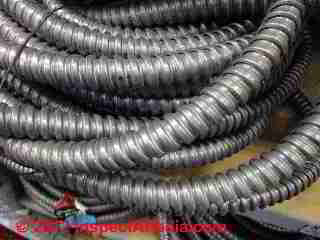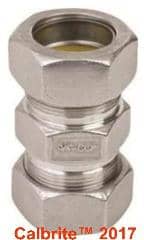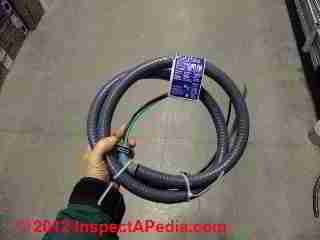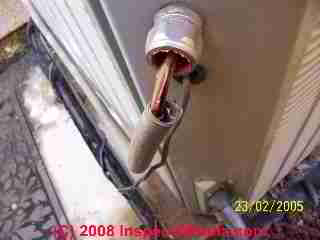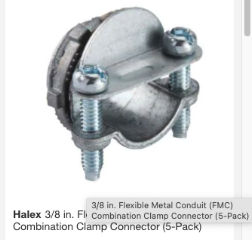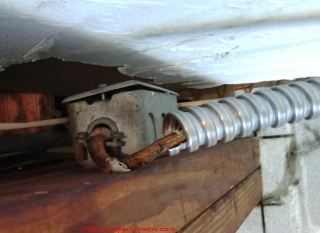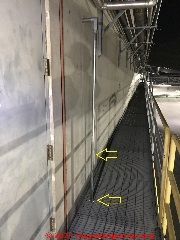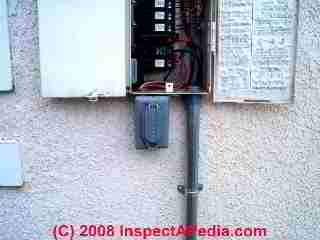 Metallic Electrical Conduit Types, Installation, Codes
Metallic Electrical Conduit Types, Installation, Codes
- POST a QUESTION or COMMENT about how to buy, bend, wire, & install electrical conduit in buildings
Metallic Electrical Conduit:
Here we describe the various types & applications of metallic electrical conduit, flexible and rigid, or conduit made of aluminum, galvanized steel, PVC-coated steel, and stainless steel. We include tips for installing & inspecting electrical conduit in homes and electrical conduit cutting, bending, installing suggestions
This article series describes both metallic electrical conduit and plastic or non-metallic electrical conduit products, and answers basic questions about installing electrical conduit. Electrical conduit is metal or plastic rigid or flexible tubing used to route electrical wires in a building.
The page top photo showing rigid conduit used to bring wires up to an electrical sub-panel was provided courtesy of Tim Hemm.
InspectAPedia tolerates no conflicts of interest. We have no relationship with advertisers, products, or services discussed at this website.
- Daniel Friedman, Publisher/Editor/Author - See WHO ARE WE?
Electrical Conduit Installation Tips for Homeowners & DIY Repairs
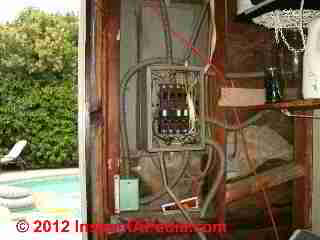 Watch Out: Do not attempt to work on your electrical wiring, switches, or outlets unless you are properly trained and equipped to do so. Electrical components in a building can easily cause an electrical shock, burn, or even death.
Watch Out: Do not attempt to work on your electrical wiring, switches, or outlets unless you are properly trained and equipped to do so. Electrical components in a building can easily cause an electrical shock, burn, or even death.
Even when a hot line switch is off, one terminal on the switch is still connected to the power source.
Before doing any work on the switch, the power source must be turned off by setting a circuit breaker to OFF or removing a fuse.
See SAFETY for ELECTRICAL INSPECTORS
and ELECTRICAL WIRING BOOKS & GUIDES
Electrical conduit for wiring has some advantages in protecting wires and also in running multiple wires to a location.
The proper selection of electrical conduit materials, fittings, and installation are important for safe electrical wiring.
Our photo (above left, courtesy of Tim Hemm), shows an electrical conduit snafu along with an unsafe FPE Stab-Lok electrical sub panel. Both flexible electrical conduit and rigid conduit were used. Our arrow points to an improper "bend" made in the rigid metal electrical conduit. [3]
Electrical Conduit Types, Applications, Codes, Standards, Sources
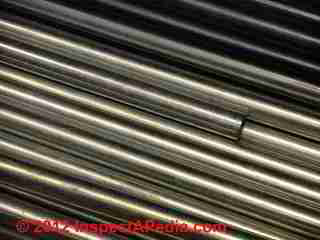
- EMT ELECTRICAL METALLIC CONDUIT - THIN WALLED METAL CONDUIT - rigid
- FMC FLEXIBLE METAL ELECTRICAL CONDUIT - flexible
- IMC INTERMEDIATE METAL CONDUIT, THREADED & NON-THREADED - rigid
- LFMC LIQUID-TIGHT FLEXIBLE METAL CONDUIT & WHIPS - flexible, liquid tight, with wire
- RMC RIGID METAL CONDUIT - rigid
- ELECTRICAL CONDUIT, NON-METALLIC
- ELECTRICAL CONDUIT PULL BOXES
- ENT ELECTRICAL NONMETALLIC TUBING - rigid plastic conduit
- ENT & LFNC NON-METALLIC ELECTRICAL CONDUIT- flexible plastic & liquid-tight flexible plastic conduit
- FLEXIBLE LFNC PRE-WIRED WHIPS - flexible, liquid-tight, with wire
Photo above: EMT, thin walled electric metal conduit. [Click to enlarge any image]
Steel electrical conduit and tubing (EMT) have been used for many decades to protect electrical wiring from mechanical damage and to provide electromagnetic field or electromagnetic interference shielding for circuits and wiring of various types.
Vendors of EMT point to both its high re-cycled content (63%) and its recyclability at the end of its life. EMT is produced either in a basic oxygen furnace (BOF) or an electric arc furnace (ARF). - (NEMA 2017)
The range of electrical conduit materials and properties is large and is designed both for special applications such as corrosion or moisture resistance.
- The inside diameters of conduit vary from the nominal diameter sizes, and include 23/32", 21 32", 5/8", 39/64", 37 64", and 2 1/16" inside actual dimensions.
- The wall thickness of electrical conduit materials ranges among 1/8", 7/64", 3/32", 5/64", 1/16" and 3/64"
- Rigid conduit is sold mostly in 10 ft. lengths with 5 ft. lengths available usually for the larger-diameter sizes.
EMT, Electrical Metallic Tubing, Thin-wall metal conduit
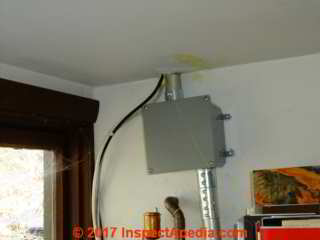 The most common type of electrical conduit for house wiring is the thin-wall type. Thin-wall conduit is too thin for threaded joints. It is joined to other lengths of conduit and to boxes by pressure-type fittings.
The most common type of electrical conduit for house wiring is the thin-wall type. Thin-wall conduit is too thin for threaded joints. It is joined to other lengths of conduit and to boxes by pressure-type fittings.
EMT Conduit is sold in two metallic types:
- 304 Stainless Steel EMT, in sizes 1/2" to 2" in diameter in 10 foot lengths (Calbrite Brand) environments.
Stainless steel EMT conduit and fittings combine strength with ductility, resulting in an affordable, lightweight and easy-to-handle conduit assembly. EMT can be installed indoors and outdoors in accordance with UL and NEC® requirements. - (Calbrite 2017)
- Galvanized Steel EMT, in sizes 1/2" to 4" in diameter in 5 ft. lengths (some sizes) and 10 ft. lengths (most diameters) (GAV, Allied and other brands)
- EMT Compression Fitting conduit, sold in 1 1/4" to 2 1/2" diameter, 10 ft. lengths, easy installation, no need to stock couplings (Allied & other brands)
- EMT Green Conduit, in steel, 1/2" & 3/4" diameter, 10 ft. lengths, hot-galvanized, used to identify emergency circuits and critical circuits in hospitals, healthcare areas etc.
- EMT with Integrated Setscrew Couplings, 1 1/4" to 3" diameter, 10 ft. lengths, simplified installations, smooth interior raceways.
- EMT Red Conduit, in steel, 1/2" & 3/4" diameter, 10 ft. lengths, used to identify fire alarm & security system wiring, hot dipped galvanized, easy-bending (Allied & other brands)
- PVC-Coated Steel Conduit such as CalPipe's Calbond™, used in hazardous locations, oil and gas, and mining industries.
PVC-coated steel conduit is produced in North America by Calpipe Industries, Robroy Industries, and by Thomas & Betts (ABB Group).
Thin-wall conduit is sold in ten-foot lengths in either one-half inch or three-quarter inch (outside) diameter.
The one-half inch conduit can contain four No. 14 wires or three No. 12 wires. Three-quarter inch conduit accommodates four No. 10 or five No. 12 wires.
These wire capacities are for individual wires, not pairs. The wires used are the same as the individual conductors found in steel armor cable and plastic sheathed cable. Wires in conduit must follow standard coding. In a two-wire electrical circuit you need one black wire, one white wire, and one ground wire.
The general procedure for using thin wall conduit is similar to the use of steel armor cable. The big difference is that conduit cannot be "snaked" through openings in ceilings and walls.
You must have full access to joists and studs to install electrical conduit. So you probably won't want to use it unless your local code requires it.
In the U.S. manufacturers of EMT or Electrical Metallic Tubing include Allied, Calbrite, and Granger-Approved brands.
Reader Comment: more wires allowed in thin wall metal conduit: NEC Table C.1
2016/08/22 Alan said:
The conduit fill listed under thin-wall metal conduit [above] is wrong. Granted, under normal conditions, you generally cannot go over 9 current carrying conductors in a conduit without needing to reduce its current carrying capacity below the size circuit for which it is generally used (e.g., #14 = 15A; #12 = 20A). A
NEC Table C.1 (for electrical metallic tubing, EMT) allows for 12 #14 and 9 #12 in 1/2" conduit, and 22 #14 and 16 #12 in 3/4" conduit.
lso, good luck pulling nine #12 wires in a 1/2" conduit, but just wanted to point out that NEC allows for more conductors than indicated above.
Also, I should note that is for THHN - other types may allow for more or less.
Spacing & Support for Rigid Metal Electrical Conduit
See NEC Table 344.30 (B)(2)
- Rigid metal electrical conduit to 1/2-3/4" or 12.7-9.1 mm: 10 feet or 3.05 meters between supports
- Rigid metal electrical conduit 1" or 24.5mm in diameter: 12 ft / 3.66 m
- Rigid metal electrical conduit 1 1/4 - 1 1/2" in diameter: 14 ft / 4.27m
- Rigid metal electrical conduit 2 - 2 1/2" in diameter: 16 ft / 4.88 m
- Rigid metal conduit 3" in diameter or larger: 20 ft or 6.1 m
EMT Resources, Sources, Standards
- Calbrite™ Corporation, 6451 Northwind Pkwy., Hobart, IN 46342 USA, Tel: 219-844-6800 Website: www.calbrite.com
- Calbrite™, Stainless Steel Conduit Systems, Stainless Steel EMT, retrieved 2017/08/08, original source: http://www.calbrite.com/submittal-sheets/Conduit/SS-EMT-Conduit.pdf
- NATIONAL ELECTRIC SURFACE CONDUIT CATALOG 1950 [PDF]
- Standard: UL / cUL 797A
- Standard: ANSI C80.3 for installation in accordance with Article 358 of ANSI/NFPA 70,"National Electrical Code" (NEC).
- Wheatland Tube, "CONDUIT TUBING, EMT, IMC, RMC" [PDF], Wheatland Tube, JMC Steel, includes 2011 National Electrical Code References. Wheatland Tube, 700 South Dock Street, Sharon, PA 16146 USA, Tel: 800.257.8182 Email: info@wheatland.com Website: wheatland.com
FMC, Flexible metal electrical conduit
Flexible metal conduit or FMC, is a helically-wound flexible metal electrical wiring conduit, often made using aluminum such as the ALFlex™ conduit shown here.
Flexible metallic electrical conduit is used principally in commercial and industrial construction world wide. In residential applications you may find FMC used to connect an electric oven or electric cooktop.
This conduit is also sold as LFMC or liquid-tight flexible metal conduit.
LFMC is described in the U.S. National Electrical Code NEC® Article 350 and must comply with UL 360 in the U.S. or CSA C22.2 No. 56 in Canada.
Flexible metal conduit is sold in rolls and cut to the necessary length, joined with appropriate fittings.
Shown is Alflex™ 3/4" diameter metallic flexible conduit produced by Titan.
[Click to enlarge any image]
Pre-Wired Flexible Electrical Conduit Whips
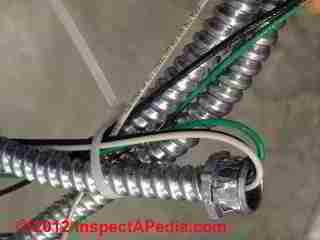
What's the Difference between Flexible Metal Electrical Conduit and Armored Cable or "BX" Wiring?
Flexible metal conduit sold for electrical wiring (previous photo above) is sold empty, and is larger in diameter than pre-wired armored cable such as the 12/3 Armorlite® armored cable shown here.
This electrical cable is pre-wired with THHN/THWN conductors and is intended for use in cable trays and includes a green-insulated ground wire.
Watch out. Do not use set-screw type connectors with this cabling.
Doing so risks pinching the cable end and cutting into the wires, causing a short circuit.
FMC and LFMC Standards, Codes, Installation Guidelines
The following Standards govern FMC and LFMC
- UL 1, Flexible Metal Conduit, Abstract: These requirements cover flexible aluminum and steel conduit designed for use as metal raceway for wires and cables in accordance with the National Electrical Code, NFPA 70.
- UL 360, Liquidtight Flexible Metal Conduit
Abstract:
1.2 This conduit is for applications in which flexibility of the conduit is necessary during installation, operation, or maintenance and the contained conductors need protection from vapors, liquids or solids.
1.3 This conduit is circular in cross section, having an outer liquid-tight, nonmetallic, sunlight-resistant jacket over an inner flexible metal core, and is for use in wet, dry, or oily locations in which the conduit is exposed but is not subject to physical damage.
Conduit that is not marked with a temperature designation or is marked "60 C" is for use at temperatures not in excess of 60°C (140°F).
Conduit that is for use in dry or oily locations at a temperature higher than 60°C (140°F) is marked " ---- C dry, 60 C wet, 70 C oil res" or "----C dry, 60 C wet, 70 C oil resistant" with "80 C" or "105 C" inserted as the dry-locations temperature.
1.4 Conduit that is marked "80 C dry, 60 C wet, 60 C oil res" or "80 C dry, 60 C wet, 60 C oil resistant" is for use at 80°C (176°F) and lower temperatures in air, and 60 °C (140°F) and lower temperatures where exposed to water, oil or coolants – that is, to cutting oils and the like in machine-tool and other industrial applications.
1.5 Conduit marked in accordance with 24.4(g) is limited to use in oil free environments.
1.6 Fittings for conduit are covered in the Standard for Conduit, Tubing, and Cable Fittings, UL 514B.
1.7 These requirements do not cover liquid-tight flexible nonmetallic conduit. Flexible nonmetallic conduit is covered in the Standard for Liquid-Tight Flexible Nonmetallic Conduit, UL 1660, and the fittings for this conduit are covered in the Standard for Conduit, Tubing, and Cable Fittings, UL 514B.
1.8 These requirements do not cover flexible metallic tubing.
1.9 These requirements do not cover electrical nonmetallic tubing (ENT).
Photo above: rigid and flexible metallic electrical conduit in an older home.
- UL 467 on
Grounding and Bonding
Abstract:
This Standard applies to grounding and bonding equipment for use in accordance with the Canadian Electrical Code, Part I, CSA C22.1, in Canada, the National Electrical Code, NFPA 70, in the United States, or the Standard for Electrical Installations, NOM-001-SEDE, in Mexico.
1.2 This Standard applies to the following grounding and bonding equipment:
a) ground clamps, bonding devices, grounding bushings, water-meter shunts, grounding electrodes, and the like used in a grounding system;
b) equipment for making electrical connections between
i) the grounding conductors used in electrical power systems, non-current-carrying metal parts of electrical equipment, armored grounding wires, metal raceways, and the like; and
ii) grounding electrodes;
c) equipment for making electrical connections between
i) the grounding conductors used in telecommunications systems such as telephone, radio, CATV, network power broadband, and the like; and
ii) grounding electrodes;
d) hospital grounding jacks and mating grounding cord assemblies (for Mexico and the United States, see Annex a);
e) bonding devices for making electrical connections between
i) the hex head of a brass fitting used in a piping system in accordance with 250.104 of NFPA 70; and
ii) the grounding electrodes; and
f) intersystem bonding terminations for connecting intersystem bonding and grounding conductors for other systems in accordance with NFPA 70. - UL 514A/CSA C22.2 No. 18.1/NMX-J-023/1-ANCE on Metallic Outlet Boxes
- UL 514B/CSA C22.2 No. 18.3/NMX-J-017-ANCE pertaining to Conduit, Tubing and Cable Fittings
- UL 514C Nonmetallic Outlet Boxes
In addition, NEMA, the National Association of Electrical Equipment and Medical Imaging Manufacturers has produced a number of standards and installation procedures, bulletins and guides for FMC and LFMC including
- NEMA RV 3-2014, Application and Installation Guidelines for Flexible Metal and Liquidtight Flexible Metal and Nonmetallic Conduits
- NEMA FB 1-2014, Fittings, Cast Metal Boxes, and Conduit Bodies for Conduit, Electrical Metallic Tubing, and Cable
- NEMA FB 2.20-2014, Selection and Installation Guidelines For Fittings for Use With Flexible Electrical Conduit and Cable
Contact NEMA at
- NEMA, 300 North 17th Street, Suite 900, Arlington, Virginia 22209 USA, Tel: 703 841-3200, Website: http://www.nema.org/
Website Excerpt:
The National Electrical Manufacturers Association (NEMA) is the association of electrical equipment and medical imaging manufacturers, founded in 1926 and headquartered in Rosslyn, Virginia.
Nearly 350 members strong, its companies manufacture a diverse set of products including power transmission and distribution equipment, lighting systems, factory automation and control systems, and medical diagnostic imaging systems. - NEMA list of FMC & LFMC standards & NEMA publications, retrieved 2017/08/08, original source https://www.nema.org/Products/Pages/Flexible-Metal-Conduit.aspx
IMC Intermediate Metal Conduit
Intermediate Metallic Conduit or IMC is lighter weight, metallic conduit and is rated as stronger than other rigid conduit. IMC was first produced by Allied Tube & Conduit.
IMC, provided in both threaded IMC and non-threaded IMC forms, is a rigid metallic conduit tubing, typically hot-dipped galvanized steel or stainless steel. The interior of galvanized steel IMC is usually coated with an anti-corrosion layer.
Threaded IMC is joined by threaded couplings, C condulets, sweeps and bends. The tubing is cut with a pipe cutter or tubing cutter, and then threads cut using a thread cutting tool. When cutting IMC, take care to remove burrs on the tubing interior that would otherwise damage electrical wires being pulled through the conduit.
IMC is typically used in hazardous locations, and in its stainless steel formulation, IMC is widely used in the food and beverage industry, in chemical plants, in cosmetic and pharmaceutcial industries, in refineries, in pulp and paper mills, in marine and coastal sites, in other corrosive environments.
An advantage of IMC is its larger interior diameter compared with RMC of the same nominal sizes, making it easire to pull wires.
IMC is sold in these forms
- 304 Stainless Steel IMC in 1/2" to 2" diameter, 10 ft. lengths (Calbrite & other brands)
- 304 Stainless Steel IMC , non-threaded IMC, 1/2" to 2" diameter, joined using compression fittings, for improved impact resistance & corrosive environments where the conduit is exposed to "washdowns"
- 316 Stainless Stee IMC l in 1/2" to 2" diameter, 10 ft. lengths (Calbrite & others)
- 316 Stainless Steel IMC , non-threaded IMC, 1/2" to 2" diameter, joined using compression fittings, for the same non-threaded IMC applications as described above.
- Galvanized steel IMC in 1/2" to 4" diameter, 10 ft. lengths (Grainger Approved GAV, Allied, other brands)
- 1/4" ID IMC is also available.
IMC Standards, Certifications, Suppliers, Product Resources
Non-threaded IMC is joined by compression fit type couplings like the stainless steel Calbrite™ IMC coupling shown here.
- Calbrite™ Corporation, 6451 Northwind Pkwy., Hobart, IN 46342 USA, Tel: 219-844-6800 Website: www.calbrite.com
- UL / cUL 1242
- Articles 342 & 344 of ANSI/NFPA 70, U.S. "National Electrical Code" (NEC)
- ANSI C80.6
- Thiele, Timothy, "What is Intermediate Metal (IMC) Conduit? Strong but Lighter Rigid Conduit", (2017), retrieved 2017/08/08, original source: https://www.thespruce.com/what-is-intermediate-metal-conduit-1152710
- Wheatland Tube, "CONDUIT TUBING, EMT, IMC, RMC" [PDF], Wheatland Tube, JMC Steel, includes 2011 National Electrical Code References. Wheatland Tube, 700 South Dock Street, Sharon, PA 16146 USA, Tel: 800.257.8182 Email: info@wheatland.com Website: wheatland.com
LFMC: Liquid Tight Flexible Metallic Conduit Whips, Pre-Wired
In nearly all new installations the electrician uses a pre-wired liquid tight electrical conduit whip (photo above) to connect outdoor electrical equipment exposed to the weather, such as an air conditioner or heat pump compressor/condenser unit.
Shown is a six-foot 3-wire Carlton Carflex™ whip assembly produced by Thomas & Betts. [5]
[Click to enlarge any image]
For special applications such as shown in our sketch (below), flexible conduit is often used for convenience or to avoid vibration problems, but steps must be taken to prevent water from entering the conduit and/or special water-resistant wiring and fittings are required.

Pre-wired whips in residential applications (photo above right) are found connecting air conditioner & heat pump compressor units to their outside power source. There the flexible whip avoids problems with vibration-loosened connections in the conduit.
Electrical whips are also used for connecting spas and swimming pool equipment.
Watch out: Flexible conduit and whips are "flexible" but not to degrees that exceed the laws of physics and the properties of the materials.
If you force flexible conduit or a pre-wired conduit whip to bend too acutely over too short a radius such as at its connection to a rigid surface the conduit will eventually break, as Tim Hemm's photograph (left) illustrates.
LFMC Resources
- Carlton Carflex™ whip
- Liquid-Tuff™ Liquid Tight FLex Metallic Conduit, Steel, PVC-jacketed Conduit, 3/8 in Through 1 1/4 in Trade Sizes are Square Lock Formed; Include an Integral Bonding Strip of Copper that is Enclosed Within the Convolutions Throughout their Entire Length, WEEE Compliant; UL-360; ANSI; CSA LL18858; UL E29278
Product Description:
For corrosive environments involving water or other liquids, choose liquid-tight flexible conduit (LFMC). When paired with the appropriate fittings (sold separately), this jacketed conduit provides a liquid-tight seal even as it bends and curves and can be used in direct burial, concrete, and lighting applications.
When environments where liquids, temperature, gas, and combustion are a concern, this harsh environment liquid-tight flexible metallic conduit is the solution. It has a PVC jacket for protection in interior and exterior locations, including direct burial and concrete. - retrieved 2017/08/08 from Grainger
RMC Rigid Metal Electrical Conduit - threaded metal electrical conduit
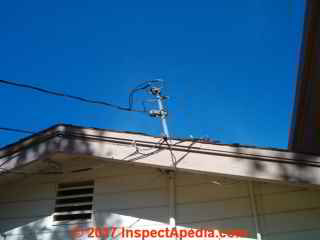 Rigid metal conduit is a heavier gauge steel electrical conduit using threaded couplings and fittings and is the thickest, or stiffest of the conduit materials used for electrical wiring.
Rigid metal conduit is a heavier gauge steel electrical conduit using threaded couplings and fittings and is the thickest, or stiffest of the conduit materials used for electrical wiring.
A typical RMC and often the only RMC residential application is to enclose the electrical service entry wiring from the electrical company's overhead wires at the mast-head down to the electrical panel mounted on the building wall.
Our photo shows a damaged, bent-over RMC masthead over a private home in New York. This sort of damage can happen when a tree falls on the electrical wires between pole and masthead.
[Click to enlarge any image]
RMC is sold in both straight lengths and into pre-formed sweeps and bends at 90° and 45° angles.
Rigid metal conduit and its necessary couplings, bends, sweeps, and Condulets that permit wiring insertion & splicing are sold in the following forms and metals:
- 304 Stainless Steel EMT, in sizes 1/2" to 2" in diameter in 10 foot lengths (Calbrite™ Brand) used in industries including chemical, food & beverage, petrochemicals, transportation, wastewater treatment, and in hazardous or explosion-risk environments.
- 316 Stainless Steel EMT, in sizes 1/2" to 2" in diameter in 10 foot lengths used as described above, to meet UL and cUL 1242A / ANSI listing standards.
- Aluminum RMC in sizes 1/2" to 4" in diameter, 10 ft. lengths, (Gav, Allied and others)
- Galvanized Steel RMC, in sizes 1/2" to 4" in diameter, 5 & 10 ft. lengths, (Gav, Allied, Power4 First, other brands)
- Galvanized Steel RMC with threaded couplings, in 2 1/2" to 4" diameter, 10 ft. lengths, simplified installation
[Photos needed - use the page top or bottom CONTACT link]
Grainger (https://www.grainger.com) lists a full inventory of types of metal and non-metallic conduit products as you may also find at your local electrical contractor-supplier and at some building supply stores such as Lowes & Home Depot.
RMC Rigid Metal Conduit Resources
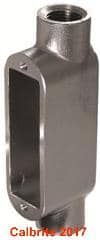 The stainless steel C Condulet shown here and used for snaking or connecting electrical wires inside of RMC is a Calbrite™ product - contact information is given below. Stainless steel RMC is used where corrosive environments will exceed the limitations
of aluminum, fiberglass, rigid steel, PVC, & PVC Coated conduit. (Calbrite 2017).
The stainless steel C Condulet shown here and used for snaking or connecting electrical wires inside of RMC is a Calbrite™ product - contact information is given below. Stainless steel RMC is used where corrosive environments will exceed the limitations
of aluminum, fiberglass, rigid steel, PVC, & PVC Coated conduit. (Calbrite 2017).
Galvanized RMC meets these standards in the U.S. & Canada
- American National Standard for Rigid Steel Tubing (ANSI® C80.1)
- Calbrite Corporation, 6451 Northwind Pkwy., Hobart, IN 46342 USA, Tel: 219-844-6800 Website: www.calbrite.com
- CSA C22.1, Canadian Electrical Code, Part 1, NOM-001-SEDE, Standard for Electrical Installations
- Underwriters Laboratories Standard for Rigid Steel Tubing (UL6)
- National Electric Code® 2002 Article 344 (1999 NEC Article 346)
- Federal Specification WW-C __581 (cancelled by the U.S. federal government that has adopted the UL6 and ANSI C80.1 standard, this specification can still be referenced) (Calconduit 2017)
- UL / cUL 6A Listed RMC
RMC Suppliers, North America
- Calconduit™, Galvanized Rigid Conduit Specifications, Galvanized Rigid Couplings, Galvanized Rigid Elbows, Galvanized Rigid Special Radius Sweeps, EMT ELbows, Aluminum Rigid Elbows, Aluminum Rigid Sweeps, retrieved 2017/08/08, original source: http://www.calconduit.com/products/galvanized-rigid-conduit.html
- Wheatland Tube, "CONDUIT TUBING, EMT, IMC, RMC" [PDF], Wheatland Tube, JMC Steel, includes 2011 National Electrical Code References. Wheatland Tube, 700 South Dock Street, Sharon, PA 16146 USA, Tel: 800.257.8182 Email: info@wheatland.com Website: wheatland.com
Tools you and procedures for bending, cutting, installing, electrical conduit
This discussion has moved to a separate aritcle at ELECTRICAL CONDUIT BEND CONNECT TOOLS
Electrical Wiring Conduit Defects Found by Visual Inspection
This discussion has moved to a separate aritcle at ELECTRICAL CONDUIT DEFECTS & DAMAGE
This website provides information about a variety of electrical hazards in buildings, with articles focused on the inspection, detection, and reporting of electrical hazards and on proper electrical repair methods for unsafe electrical conditions.
...
Reader Comments, Questions & Answers About The Article Above
Below you will find questions and answers previously posted on this page at its page bottom reader comment box.
Reader Q&A - also see RECOMMENDED ARTICLES & FAQs
On 2021-10-21 by inspectapedia.com.moderator (mod)
@Anonymous,
You're welcome.
On 2021-10-21 y Anonymous
@Carl Youngblut, thanks!
On 2021-10-20 6 by inspectapedia.com.moderator (mod)
@Carl Youngblut,
Because I have not found a rigid metal or plastic conduit that was sold pre-wired, I think you're going to be looking at a pre-wired flexible conduit either metallic or nonmetallic. This flexibility also allows you to install wiring without having to cut it to an exact length.
On 2021-10-19 by Carl Youngblut
Which type conduit *pre-wired or other) would be best for a dedicated 220V circuit (maybe 25 ft) from breaker box to a socket for EV charging in garage.
Looking to do the "install" of conduit and wiring along wall before calling electricial to hook to cuiruit box and wall socket. Thanks.
On 2021-09-14 by inspectapedia.com.moderator (mod) - example of improper, unsafe flexible metal conduit (BX) connection
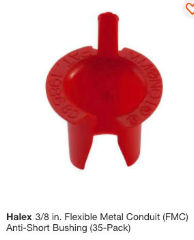 @Mel,
@Mel,
Shown here is an example of the anti-short bushing I mentioned; this bushing is pushed into the cut-end of the FMC conduit (or BX cabling) to prevent the sharp cut ends from damaging the electrical wire insulation.
On 2021-09-14 by inspectapedia.com.moderator (mod)
@Mel,
Your photo shows an improper and unsafe "repair"
1. There is no proper connection between the flexible conduit and the metal electrical box.
An example BX or Halex connector is shown below though there other types of connectors that can also work properly with flexible metal conduit (FMC).
2. There is no anti-short plastic bushing (I will show an example in a second photo attachment - as advertised by building suppliers like Home Depot).
The risks include
3. sharp edges of the flexible metal conduit can cut the insulation of the live or neutral electrical wire causing a short circuit, fire, or dangerous electrical shock
4. the absence of a FMC connector permits the wires to be pulled out of the electrical box or damaged where they pass into it, also risking a short circuit, fire, or dangerous electrical shock.
I'm surprised that a licensed electrician would have done the work shown in your photo. And I would not expect the work to be accepted by an electrical inspector. In my opinion it is, as you suggest, unsafe.
On 2021-09-14 by Mel
I have braided wiring from a connection box to a new FGCI outlet which is frayed. An electrician put aluminum flexible conduit hard from the outlet a to the junction box without replacing the braided wire or hard connecting the conduit to the junction box.
It seems like it does not address the inspection issue of frayed braided wire correction.
On 2021-03-09 by (mod) - maximum support distance for conduit, MC and romex
@Lavell,
I took a look at the article above on this page where we see
Spacing & Support for Rigid Metal Electrical Conduit
- ee NEC Table 344.30 (B)(2)
Rigid metal electrical conduit to 1/2-3/4" or 12.7-9.1 mm: 10 feet or 3.05 meters between supports
- Rigid metal electrical conduit 1" or 24.5mm in diameter: 12 ft / 3.66 m
- Rigid metal electrical conduit 1 1/4 - 1 1/2" in diameter: 14 ft / 4.27m
- Rigid metal electrical conduit 2 - 2 1/2" in diameter: 16 ft / 4.88 m
- Rigid metal conduit 3" in diameter or larger: 20 ft or 6.1 m
On 2021-03-08 by Lavell
What is the maximum support distance for conduit, MC and romex.
My understanding is 4’ max in city of Reno, NV.
On 2020-06-05 by (mod) - Is it legal to run IMC conduit through a catwalk?
Jesse
Metal conduit can be run along a catwalk but ought not be on the walking surface, needs to be secured, and protected against damage.
At the very least, that vertical electrical conduit run that projects out into the walking space may be unacceptable to your local electrical code compliance inspector or to an OSHA inspector.
On 2020-06-05 by jessetrelles
Is it legal to run IMC conduit through a catwalk?
On 2020-06-05 by Jesse Trelles
Is it legal to run IMC conduit through a catwalk?
On 2019-10-03 by (mod)
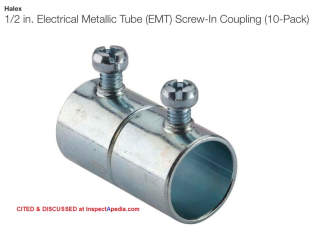 Barney
Barney
Thanks for an interesting question. I assume you're asking about screw-type electrical conduit fittings like the Halex brand fitting shown below.
OPINION: If the fitting AND conduit are listed for electrical wiring then it ought to be fine. I agree, however that thin wall metal conduit might be crushed by a ham-handed installer.
In fact I've seen an analogous problem that caused shorted electrical wiring in an NYC apartment but involving flexible armored able (BX wiring) whose fitting screws at the boxes were so over-tightened that the conduit bit- into and cut the wire insulation shorting both some hot wires and some neutral wires to ground. It was a bear to fix.
That didn't prevent those fittings from being UL-listed and widely used for many decades.
Shown here is the product description from Home Depot
The Halex 1/2 in. Screw-In Couplings (10-Pack) are designed to join and effectively bond 2 lengths of EMT conduit. They are made of galvanized steel. It can be used in any indoor or concrete-tight application.
Ideal for connecting 2 lengths of EMT conduit
Made of corrosion-resistant galvanized steel
UL listed
Can be used in indoor or concrete-tight applications
On 2019-10-03 16:59:11.222084 by Barney King
Is it acceptable to install screw-type fittings on exterior EMT that houses fire alarm wiring (vs. compression-type connectors). What NFPA 70 guidance requires compression vs. screw-type? Is there a concern of damaging the electrical line?
...
Continue reading at ELECTRICAL CONDUIT, NON-METALLIC or select a topic from the closely-related articles below, or see the complete ARTICLE INDEX.
Or see ELECTRICAL CONTUIT, METALLIC FAQs - questions & answers posted originally at this page.
Or see these
Recommended Articles
- ELECTRICAL CONDUIT, METALLIC
- ELECTRICAL CONDUIT, NON-METALLIC
- ELECTRICAL CONDUIT PULL BOXES
- ELECTRICAL CODE BASICS
- ELECTRICAL CONDUIT BEND CONNECT TOOLS
- ELECTRICAL CONDUIT DEFECTS & DAMAGE
- ELECTRICAL WIRING BOOKS & GUIDES
- NATIONAL ELECTRIC SURFACE CONDUIT CATALOG 1950 [PDF]
- SAFETY for ELECTRICAL INSPECTORS.
Suggested citation for this web page
ELECTRICAL CONDUIT, METALLIC at InspectApedia.com - online encyclopedia of building & environmental inspection, testing, diagnosis, repair, & problem prevention advice.
Or see this
INDEX to RELATED ARTICLES: ARTICLE INDEX to ELECTRICAL INSPECTION & TESTING
Or use the SEARCH BOX found below to Ask a Question or Search InspectApedia
Ask a Question or Search InspectApedia
Try the search box just below, or if you prefer, post a question or comment in the Comments box below and we will respond promptly.
Search the InspectApedia website
Note: appearance of your Comment below may be delayed: if your comment contains an image, photograph, web link, or text that looks to the software as if it might be a web link, your posting will appear after it has been approved by a moderator. Apologies for the delay.
Only one image can be added per comment but you can post as many comments, and therefore images, as you like.
You will not receive a notification when a response to your question has been posted.
Please bookmark this page to make it easy for you to check back for our response.
IF above you see "Comment Form is loading comments..." then COMMENT BOX - countable.ca / bawkbox.com IS NOT WORKING.
In any case you are welcome to send an email directly to us at InspectApedia.com at editor@inspectApedia.com
We'll reply to you directly. Please help us help you by noting, in your email, the URL of the InspectApedia page where you wanted to comment.
Citations & References
In addition to any citations in the article above, a full list is available on request.
- [3] Timothy Hemm has provided photographs of various electrical defects used at the InspectAPedia TM Website. Mr. Hemm is a professional electrical inspector in Yucala, CA.
- [4] NFPA - the National Fire Protection Association can be found online at www.nfpa.org
- [5] The 2008 NEC National Electrical Code (ISBN 978-0877657903) Online Access LINK (you'll need to sign in as a professional or as a visitor)
- [6] Thomas & Betts Corporation, Memphis TN, website: www.tnb.com.
- In addition to citations & references found in this article, see the research citations given at the end of the related articles found at our suggested
CONTINUE READING or RECOMMENDED ARTICLES.
- Carson, Dunlop & Associates Ltd., 120 Carlton Street Suite 407, Toronto ON M5A 4K2. Tel: (416) 964-9415 1-800-268-7070 Email: info@carsondunlop.com. Alan Carson is a past president of ASHI, the American Society of Home Inspectors.
Thanks to Alan Carson and Bob Dunlop, for permission for InspectAPedia to use text excerpts from The HOME REFERENCE BOOK - the Encyclopedia of Homes and to use illustrations from The ILLUSTRATED HOME .
Carson Dunlop Associates provides extensive home inspection education and report writing material. In gratitude we provide links to tsome Carson Dunlop Associates products and services.


